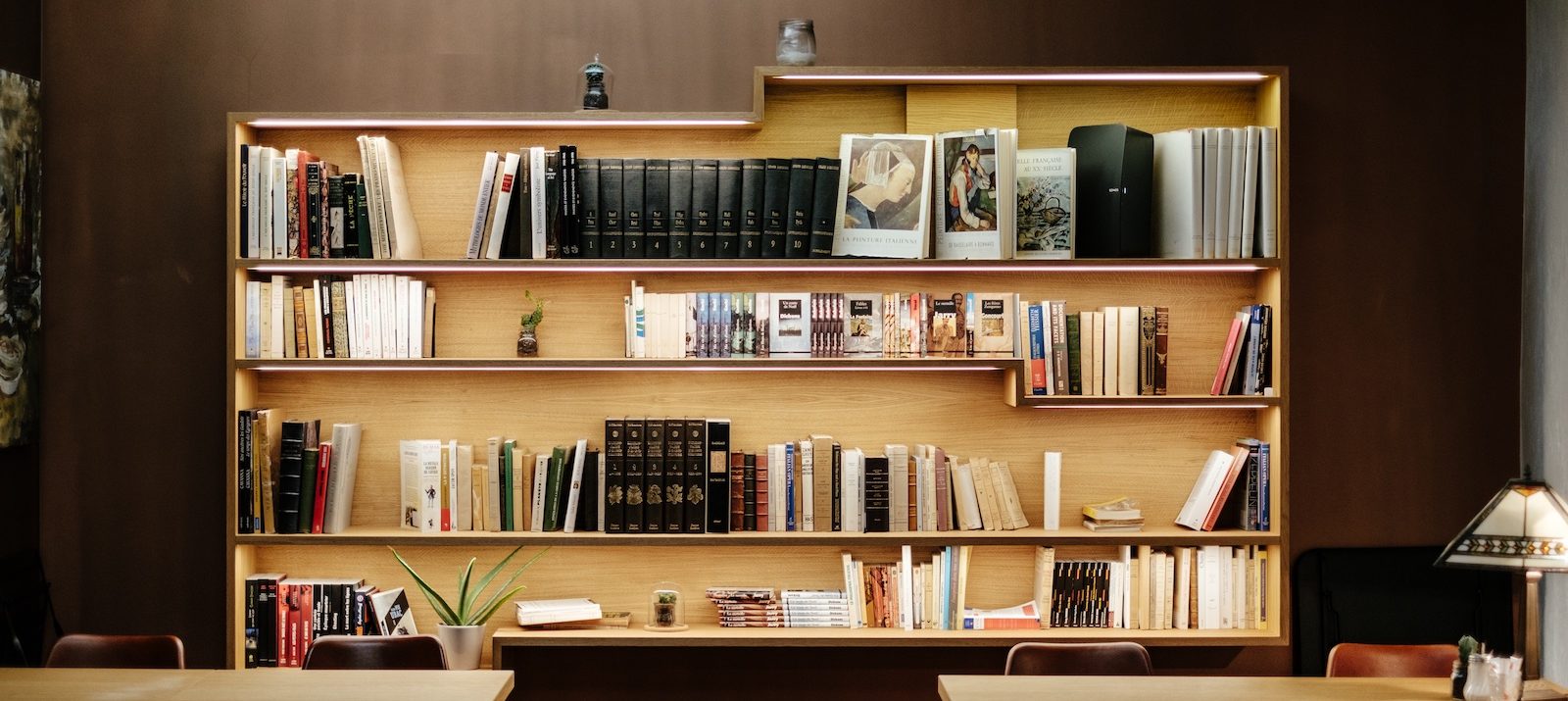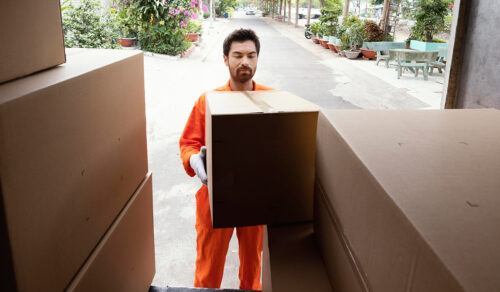The benefits of getting organized are endless: There’s less housework. Goals become clearer. There’s more space for things you love. You may even sleep better.
There’s just one hurdle: The journey from Clutterville to Tidy Town can be bumpy.
To make your ride as smooth as possible, we asked 24 top professional organizers to share their best organizing tips and ideas.
All aboard!
Store with Peace of Mind—Secure Your Space Today!
5 Benefits of Staying Organized
- Increases Productivity: When every item is in its place, you spend less time looking for things and more time getting things done. An organized space helps you to concentrate and work more effectively.
- Reduces Stress: Clutter often leads to overwhelm. A tidy space gives you a sense of control, helping to reduce anxiety and create a calming environment.
- Saves Time: Time spent in the search to find those ‘missing’ items adds up fast. With being organized, time is saved when looking for what you need, so there will be more time available for pursuits of greater importance.
- It increases creativity: A clutter-free space encourages a clear mind, allowing you to think freely and come up with new ideas without the mental distractions that clutter brings.
- Promote a healthy lifestyle: Proper organization brings about healthy lifestyles, a place that stays clean, and personal habits lead to healthier physical and mental lifestyles.
65 Best Organizing Tips and Ideas From Professional Organizers:
How to Organize Your Stuff Before It Goes Into Storage
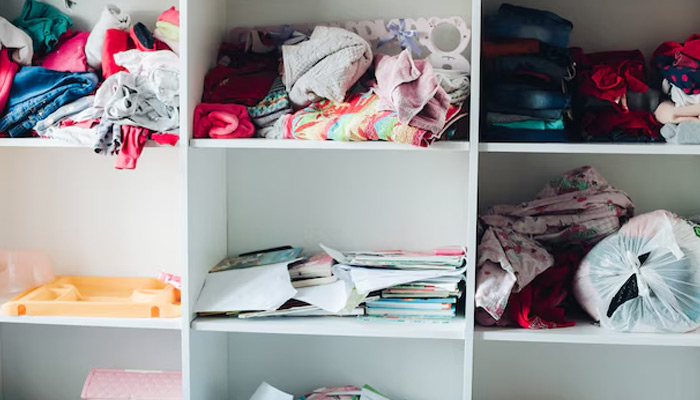
1. Pare down
This step might be a little painful depending on what you’re storing, but it can be one of the most effective—not just in managing the load but in going through your things and understanding what you have in front of you. You can go with the classic choice of figuring out what sparks joy or you can simply go based on what you actually need and use. Especially if you happen to be moving, getting rid of a few things can reduce a lot of the stress involved.
2. Disinfect
While you’re cleaning out, you may want to make sure you’re literally cleaning out. Things can get dirty when you store them for a while, and if you find yourself moving during COVID, you can never be too careful. This can even help you be more thorough as you organize your things.
3. Create a system
When it comes to the meat of the organization process, finding a system that works for your process and your belongings will lead you toward a successful move. Everyone is different, which means that someone with lots of clothes will likely have different needs from someone with an abundance of comic books. Maybe you need to organize things by year or by material. Look up the needs of your possessions and plan accordingly.
4. Label
When you pack things away, keeping track of what goes where can sometimes be a bit of a challenge, and it becomes even more important when some items are fragile or require specific storage conditions. Use a label maker to label boxes and bins specifically based on their contents so when you move things to the storage facility, you can keep things moving smoothly with minimal mistakes.
5. Use coordinating boxes
While this might not always be possible, using boxes and bins that can easily stack on top of one another, fit into one another, or store easily together is one of the best ways to stay organized when moving things into storage, both in the moment and when you need to find things again at a later date. If you can find matching or coordinating boxes for your things, you should definitely do it.
6. Organizing before you store
While getting organized may not always seem worth it, but when you organize your stuff before it goes into storage it can make your life so much easier.
How to Organize Your Kitchen
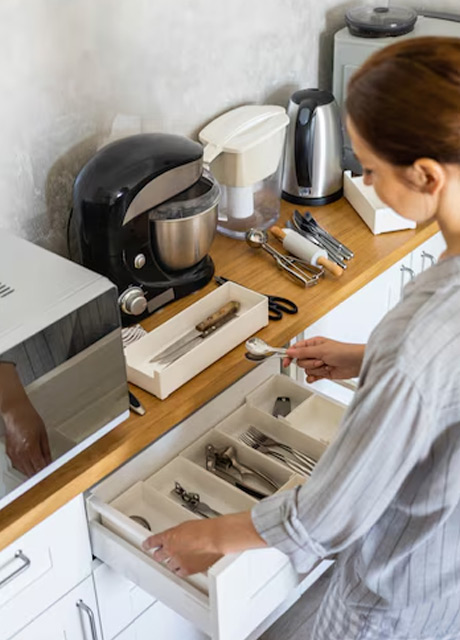
7. Tidy up while cooking
Wash or put items in the dishwasher as you go. Put things away as you go. For example, if you’re done with the flour, put it away. If you’re done with a condiment, put it away.
When possible, prep food items ahead of time.
Determine when you need dishes to be ready and work backward, time-wise.
8. Use produce drawers as time capsules in your fridge
Most refrigerators have two produce drawers. Instead of dividing produce by category into the drawers, try this trick:
When you are checking the fridge before you shop, toss out the unusable things in the drawers. Move everything to the right drawer which you have labeled with a sticky note. Eat these produce items first. Once you have new produce, put it all into the left drawer.
9. Use clear (preferably glass) storage containers for food
Regular plastic storage containers are cloudy and hard to see into. Take-out containers are even worse!
Put your leftover food and ingredients into sturdy containers with safe-sealing tops (I love the Pyrex ones) to clearly see what there is to eat in the fridge and freezer. I often store these containers full of food upside down for even greater visibility. Crazy!
10. Use a Lazy Susan for overlooked olives
Who can remember what condiments are hiding in the back of the refrigerator? Not me! I gotta see it to believe it. So, I use two Lazy Susans in the fridge. One is for pickles and olives. The other is for rarely used condiments. No more buying what you already have.
11. Tackle the black hole in your freezer
Most freezers are extremely hard to keep organized. The main problem is the things we store in there are all weird shapes and sizes. Hello turkey carcass for making soup!
Use a small cookie sheet to freeze your liquids into nice flat solids right in Ziploc bags. Then you can stack the solid bags. (Write the contents on the bag before filling it.)
Stack clear, glass storage containers for non-liquids in the freezer. Label them with a little piece of paper that sticks out of the lid.
An organized home doesn’t just happen – it is the result of specific habits and routines that help one maintain a clutter-free environment long-term. Here are some habits that professional organizers, and organized people in general, use every day that help keep their homes neat and organized:
12. Declutter your kitchen cabinets
Start by emptying out everything on your counters or table. Sort like with like. Get rid of everything you will not use or eat: donate still-good food to a local food bank, and discard anything that’s no longer consumable.
Zone the cabinets before you put things back: baking, cooking, storage, utensils, sharp items, dish towels, dishes, serving pieces, canned goods, spices, and sauces. Wipe and clean the cabinets thoroughly. Use Lazy Susans, bamboo drawer dividers, or wire shelves to corral smaller items such as spices, herbs, utensils, and hand tools.
Load everything back in, according to the zones you’ve created. Label the drawers/doors if needed for the first week or so, until you remember where things live now.
Bedroom
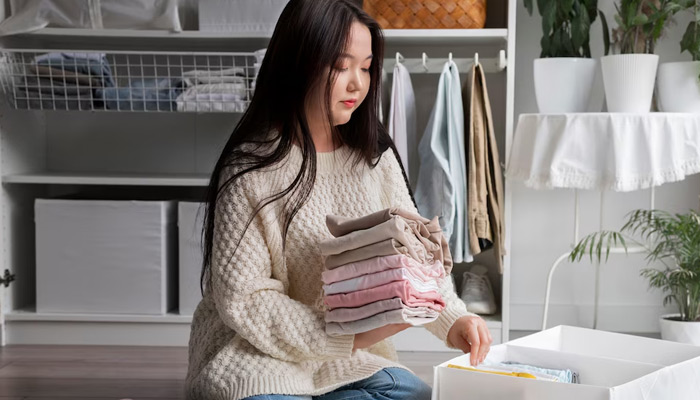
13. Make your bed every morning
Since your bed is the dominant feature in your bedroom, a made bed will make your whole room feel orderly. Bonus: This task takes less than two minutes.
14.Respect, don’t neglect, your bedroom
It’s tempting to store suitcases in a corner “just for now,” to pile up clothes that need to go to the cleaner or tailor or to leave unfinished projects and papers strewn all over the dresser.
Banish anything that isn’t related to dressing, sleeping, relaxation, or romance. Relocate items to other rooms or closets – or let them go. Add fresh flowers or a candle.
15. Prime your bedroom for relaxation
Many people decide to eliminate TVs and other electronic equipment from the bedroom. Placing a desk somewhere other than the bedroom might be a good idea. Work, bills, paperwork, and other clutter leads to poor sleep and an unsexy environment.
Make your bed every day to ward off the piling of books, magazines, and other stuff.
Check-in with yourself and your partner about how you feel in your space frequently.
Learn more: 9 Creative Book Storage Hacks For Small Apartments
16. Limit your nightstand contents to vital objects
Items like eyeglasses, hand cream, ChapStick, a phone charger, and a nightly read (e.g., book, magazine, or e-reader) are the standard for this storage spot. If your necessities list is longer, by all means, don’t stop yourself from having the items within arms’ reach.
If you depend on your nightstand for extra storage, just make sure you are strategic about what goes inside. It’s easy for an empty drawer to turn into a junk catch-all, so in order to prevent that from happening, give it a purpose before you start storing. Stick with one or two categories (e.g., sunglasses and jewelry) so that you know exactly what’s stored inside when you need it.
17. Make your wardrobe space-efficient
Keep only clothing in your bedroom in the current season. Have the right amount of drawer and hanging space. If you create a routine of hanging up your daily clothes when you come home, this habit will keep clutter at bay.
18. Tackle any closet build-up with these basic starts
Remove all extra hangers. Recycle, give away, or reroute hangers that don’t belong.
Pick up your clothes from the closet floor. Hang them up or reroute to laundry, dry cleaners, or giveaway.
Set the timer for 10 minutes, and quickly remove clothes that you absolutely no longer want. Reroute them to give away.
Voilà! This is a great beginning. Your closet feels more spacious and is on its way to being clutter-free.
19. Maximize what’s available in your closet
If you can see the back wall of your closet, you are not utilizing all its space.
Instead of piling hats on a shelf, install some hooks and hang your hats on the walls inside your closet. Hang clothes on the same type of hanger by style, and then by color. Make sure they are all facing the same direction.
20. Keep a donation bag in each of your clothes closets
You now have a place to keep clothes you no longer like or that no longer fit until you have the time to take them to a resale shop.
Bathroom
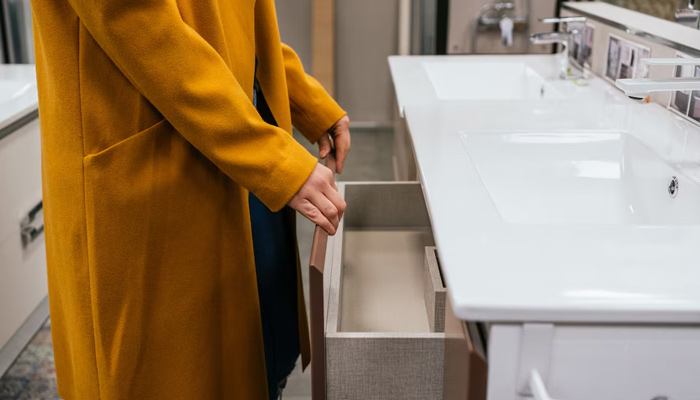
21. Dispose and reassess toiletries
Purge any expired products. Both over-the-counter medications and prescriptions have expiration dates. And makeup, once the package is open, is a breeding ground for bacteria. Check dates and dispose of old products every six months.
Use acrylic makeup organizers that will hold your toiletries upright in your vanity.
Use drawer organizers inside shallow bathroom drawers to separate cosmetics.
Use apothecary jars to store small items like hair elastics, chapstick, q-tips, and makeup applicators.
Use vanity accessories like a soap dispenser, soap dish, and tissue box holder for a polished look in your bathroom.
Learn more: 11 Beautifully Easy Makeup Storage And Organizing Ideas
22. Go paperless when you can
Set up automatic payments for monthly bills and make sure companies don’t send paper mail – all the information you need will be available online.
Send junk mail straight to the recycling. Don’t even let garbage mail hit your counter or tabletop – pull it out of the pile as soon as you can and send it to the trash. Only keep important mail that involves items you have to address.
File important papers in an accordion folder. Its size will keep your papers down to a minimum. And remember: There are very few that you actually need to hold on to.
23. Let your space define how much you can own
To prevent your stuff from taking over your home, decide how much space you want to allocate to a particular item, and then stick with that.
Here’s an example: I have one drawer in my dresser that I’ve allocated to sweaters. I don’t allow myself to own any more sweaters than can fit in that drawer. If I buy a new sweater but the drawer is full, I have to get rid of a sweater. I can’t put it in another drawer or on a shelf in the closet.
It’s the same with my shoes. If my shoe bag is full, I can’t buy a new pair of shoes unless I give one away. By creating limits for myself, I ensure that I continue to live comfortably in a small space.
Living Room
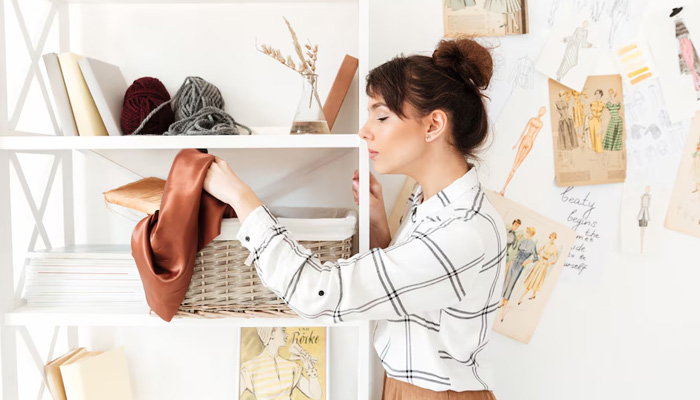
24. Accept that you probably do need to declutter
You may think you don’t have anything you want to get rid of but believe me, you probably do. Even if you’ve carefully pruned before a move, you will likely still pull items out of a box and think, “Why did I bring this?”
Life tends to bring new items into our space each day, and we frequently fail to recognize the pace at which we are accumulating things.
25. Let yourself let go
Ownership is overrated. Often we feel that we need to own something to enjoy it. In reality, we may get more pleasure out of borrowing or renting something. Anything we own requires that we clean it, move it, store it, maintain it, and maybe insure it. This all takes energy. Be open to alternative ways to access and enjoy physical objects.
26. Put items away now, rather than later
It is very tempting to put something down rather than away. We tell ourselves we will put it away later, but then life gets in the way and it never happens. If you can, push yourself to get the item to its final destination in the moment.
27. Recommended organizing and decluttering books
Peter Walsh’s It’s All Too Much gives a rip-the-Band-Aid-off approach to decluttering, and most importantly, on making space for the things that are important to your life.
Julie Morgenstern’s Organizing From the Inside Out helps people figure out what some of their blocks are to organizing. She also provides a reusable formula for tackling any organizing project, whether it’s a wallet or your garage. I use that formula when working with my clients, and in my own life.
Getting Things Done by David Allen is great for productivity and time management. Even if you use just his core methodology, you’ll live a much more peaceful and productive life, with fewer things slipping through the cracks.
Once I get my client’s space organized, it’s up to them to maintain the systems we put in place. I love the book The Power of Habit by Charles Duhigg. It teaches us that if we don’t put habits in place, we get frustrated when getting and staying organized. It’s full of anecdotes and science, but presented in an interesting and intriguing read.
28. Don’t be too hard on yourself when decluttering
Oftentimes, I hear my clients criticize, judge, and condemn themselves for the way they have let things become.
Decluttering and organizing take time and can be hard work. So definitely don’t beat yourself up and tear yourself apart as you go. Keep your focus on where you are headed, not on where you have been.
29. Use decor to make your home organized and happy
Surround yourself with things you love. This could be a color scheme, a certain style of art on the walls, furniture from a special era, a particular brand of cookware/dishes/glasses, or photographs of your loved ones.
Incorporate nature, as plants bring the outside in and infuse life into your space. The same goes for natural light, which can improve your mood.
Lastly, label as much as you can. With items continuously going back into the same place, you’ll create a sense of order that will keep household members on board as well.
Home Office
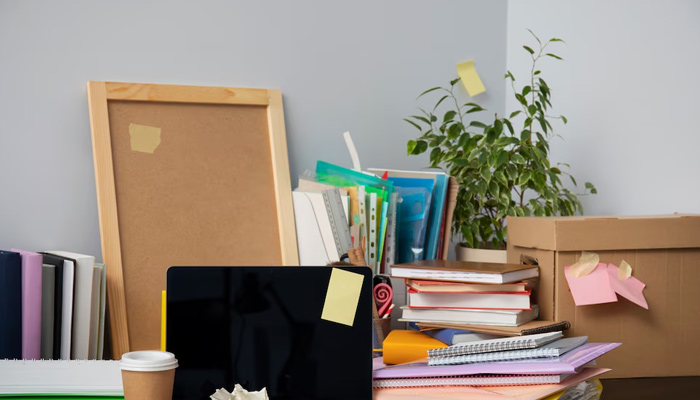
30. Think of your desk as a command center
All of the items that you need to do your job must be within arm’s reach when you are sitting at your desk. The tools that you keep in this space should be customized so that they support your daily activities and tasks.
By doing this, you will be much more effective and more productive.
31. File, don’t pile
Paperwork is always better stored vertically than horizontally. Piles are difficult to sort through, and typically only provide a reminder of the page that is on the top. Even in a mostly paperless environment, there will still be some paper, so have either a file drawer or box where this paper belongs.
Separate the action space from the storeroom. Often we buy office products in bulk (e.g., a box of pens and a 20-pack of sticky notes). Don’t keep all of them on your desk. Keep one or two of each supply at your desk, but set up a separate supply space for the bulk packages. When a pen runs dry, throw it away and go get another from your storage area.
32. Be constantly aware of your limits
When it comes to organizing and living with less clutter, something that we can all do very easily is to be more conscientious consumers and live within our spatial means.
By asking ourselves a few questions before we bring something home, we can easily help stop the clutter before it enters our house. A few example questions are, “Do I have space for this item?” “Do I need this item?” and “What am I willing to donate so that I do have room for this new item?”
33. Maximize vertical space
Maximize your vertical space at home to capture every usable inch.
Install shelves to hold books and decor, and add baskets to store miscellaneous items. Double hang your clothes in your closet to double your hanging space. Hang kitchen cabinets all the way to the ceiling to maximize vertical space, and put a shelf below to easily access frequently used dishes.
The large area on the back of a door is almost always overlooked as a way to claim vertical space. Use an over-the-door shoe hanger to store much more than just shoes. Try one out with toys in a child’s room, or hats, gloves, and scarves in a hall closet. You could even use it to store cleaning supplies in a laundry room.
34. Keep sentimental papers in check
Don’t hold onto every card just because it was once special. I advise having one plastic container for sentimental items and don’t let it overflow – if something new comes in, reconsider what you’re holding onto.
35. Keep a trash bin as close to the mailbox as possible
The vast majority of the mail you receive will be junk. Throw it away [or recycle!] before it clutters your main living space.
36. Attain inbox zero
Sign up for Unroll.me to get rid of all unwanted subscriptions. Create a separate email address just for subscriptions and online shopping, and migrate everything to that address so your personal one is reserved exclusively for actual correspondence.
Use your app’s rules or filters to pre-sort emails into clearly labeled subfolders.
Schedule appointments with yourself for any action items, and delete emails instead of allowing them to stack up in your inbox as a “tickler” or reminder.
37. Locate any paper – in under one minute
There are only three decisions when it comes to paperwork: Act on it, trash it, or file it.
File your paperwork weekly so it doesn’t accumulate into a mountain of filing that you dread addressing and ultimately ignore. Before you start filing, separate the pile into categories to easily view and assess each category as a whole.
A good filing system has a category and subcategory for every paper you need to store, keeps necessary papers easily retrievable, and keeps you on top of bills and other important documents.
38. Customize your journals and notebooks to your needs
The beauty of a blank journal and notebook is that you can create and organize information however you like.
First, think about how you’d like to use your notebook, be it for personal use, work, or school. What information are you going to store/organize/retrieve in your journal?
The next step is to sketch out the journal/notebook contents. Some ideas include dating pages and entries, and creating sections for a table of contents, index, and charts.
Once you’ve finalized your plans, you can start customizing your notebook according to your plans.
8 Best DIY Organizing Ideas
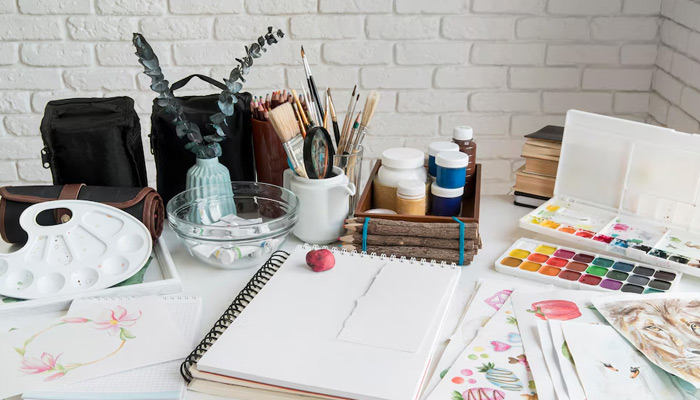
39. Tips for staying on top of a move
Make a “moving” notebook, and make sure it never leaves your side. Keep track of everything related to moving: Pre/post-move information, schedules, master list of all your boxes, checklists, tasks, contacts, and resources. With everything accessible in one place, unpacking in your new space will be a much smoother process.
Prepare an “Open me first” box ahead of time. This is the box (or suitcase) containing immediate essentials: toiletries, food/snacks, medicines, pet supplies, a couple of days’ worth of clothing for all family members, important documents, entertainment for the kids, electronics, bedding, towels, scissors/tape, paper/pen, knife/corkscrew, and cleaning supplies.
Once you’ve arrived, unpack the rooms you need to use the most first: Kitchen, bathroom, bedroom. Stay focused and complete each one before moving on to the next.
40. Label, label, label any at-home storage
I.D. the contents of containers so you know what’s inside.
Clearly label file folders by topic.
Note what’s in a box before you stow it in a closet or in the garage.
Label the inside edge of a drawer or the inside of a cabinet door so it’s obvious what’s stored where.
Go pro with a label maker (I love the Brother P-Touch), or simply use a Sharpie marker.
41. Practice the art of purging
We all have too much stuff (yes, even organizers have more than they need). If we don’t regularly and open-heartedly let go of things, the abundance of stuff starts to slowly overcome us and we find ourselves getting overwhelmed and squeezed out by our possessions.
Once we start to practice the art of purging, we are continually looking for what can be let go of.
This piece of advice actually benefits us in two ways because we also start to think more carefully before bringing more stuff into our lives.
42. Do a purse purge
Never again be the person in line fumbling through your bag looking for your wallet, or standing in the rain searching for car keys.
Organize your purse contents using small mesh pouches with zip closures. Have one for your toiletries (lipstick, hand sanitizer, tissues, gum), one for electronics (headphones, phone charger), and one for other items (pen, small paper pad, etc.).
When items are no longer running free range along the bottom of your purse or hidden in pockets, you’re able to easily pull out and access the pouch you need. Remove any accumulated trash at the end of the day to give your purse a reset.
43. Use more hooks
Hooks involve much less work than hangers. Place them low enough so your children can easily hang up their own coats, backpacks, and gear.
44. Develop time-management skills
Always live in the math: 24 hours in a day, 168 hours in a week. If you aren’t in the math, you’re in the story, and the story seldom has a happy ending.
If you want a simple life, make simple choices. Think each choice through to its natural conclusion. Don’t stop examining the choice without carefully considering all the costs – both immediate and in the future.
Every person should do a set of core value exercises to gain complete clarity on what is important to them. If you live or work with anyone, you should do them as a family, team, or roommates.
Someday doesn’t exist.
There is no such thing as multitasking. You can’t bake a cake and do open heart surgery at the exact same time.
45. Make sure the kids are organized, too
Kids are constantly growing, and their rooms need an occasional review to ensure that they keep pace.
Organize age-appropriate books on a bookshelf in themes: fiction, non-fiction, history, or poetry. Create a cozy corner for reading. Clear off a desk for studying and provide good lighting and a comfortable, sturdy chair.
In the closet and dressers, donate outgrown clothes. If you can, remove most of the toys and place them in the playroom to make the bedroom a haven of quiet reading, studying, and sleeping.
8 Organization Hacks for Small Spaces
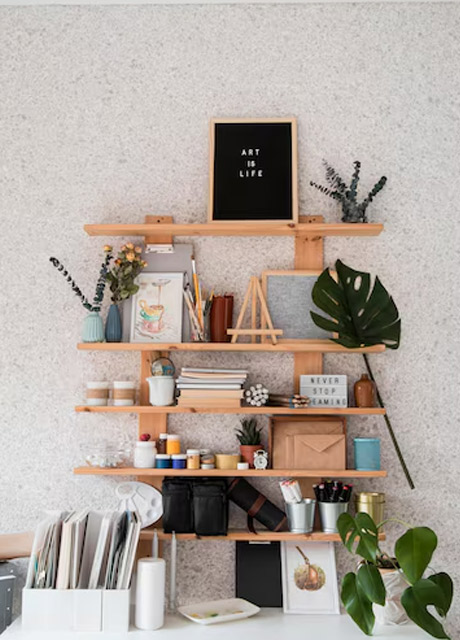
46. Be closet conscientious
The average person wears 20% of their clothes 80% of the time, so edit your closet twice a year and donate unwanted items.
To keep the closet organized, color code from light to dark. Invest in slim hangers to maximize space, and use shelf dividers to keep sweaters from tumbling.
47. Restrict items in your office space to what you really need
A pad of paper and pen are always helpful for jotting down the thoughts and reminders filling your head. Headphones or noise-canceling earbuds are great for blocking out noise and helping you focus. And a calendar nearby (digital or hard-copy) is a necessity to keep your schedule in check.
If you have the available space, add a personal touch with framed art or a plant.
Use structure in drawers. There is no way to keep small supplies from sloshing together if you don’t have a drawer organizer. Measure and get inserts to keep like items together.
48. How to determine if your clutter is, well, clutter
Clutter is sometimes hard to recognize. We live in our houses day-in and day-out, where clutter becomes part of the landscape. We don’t recognize piles and groupings of stuff because it’s become the norm. We have gotten pretty good at ignoring clutter, or just plain not realizing it’s moved in.
It usually doesn’t show itself until you can’t find what you’re looking for, or realize you have bought something you already had – costing time and money.
My recommendation for individuals wondering if they have clutter is this: Take a photo of the space. Start small with a drawer, a closet shelf, or a bookcase. Zoom in on the photo. How does the stuff make you feel? Do you use it all? How often? How would your life feel if the space was tidy, leaving room to grow?
The answers to these questions will be great indicators of the work that needs to be done.
49. Prevent future clutter by developing a steady awareness of what you are doing
If you have just entered the house with groceries or purchases in hand, take time to put them away. The few minutes spent doing this minimizes clutter that might otherwise collect in hallways, corners, and floors.
50. A place for everything, and everything in its place
To stay organized anywhere, be mindful of everything you bring in through your front door. Everything needs its own home – don’t bring it in unless you know exactly where it’s going to live.
51. Treat your surfaces wisely
The more surface space you have in your house, the more opportunity for clutter, because people feel entitled to put things down on it – even if that’s not where the item belongs. So take away extra furniture surface space if you can.
But most importantly, either give everything you own a “home,” or get rid of it.
52. Find your packing harmony
Strike a balance between packing too far in advance and not waiting until the night before the trip. I always recommend that the packing take place the weekend before the trip. Generally, you’re calmer then, and if there are things you need, you’ll have time to purchase them.
Pack small items in individual Ziploc bags. For example, children’s underpants and socks can be stored in a Ziploc bag, and then placed in a suitcase.
Pack the suitcase in layers, and place heavier items on the bottom. For example, shoes go on the bottom of the suitcase along with jeans and sweatshirts, which are heavier than a silk blouse you may want to lay on the very top.
Put layers of tissue paper between items of clothing to prevent wrinkling.
Carry prescription medicines, cameras, laptops, and any expensive jewelry onboard with you.
For airline travel, employ “the rule of fractions.” If there are four people in your family, pack a fourth of each person’s clothing in each piece of luggage. If luggage is lost or stolen, everyone will have enough to wear until it’s found.
53. Embrace the power of uni-tasking
We’ve gotten used to things happening quickly on the computer. If something takes more than 10 seconds to open, it feels like forever.
Maybe we’ll start looking for something to do while waiting. For example, I may go back to my e-mail program to see if I can read and eliminate another e-mail. By the time I am done, I may have forgotten about the other task I had started to do.
Or I’ll get back to the program I was opening — my browser, or one of my desktop apps — and I can’t remember why I opened it!
Make the commitment to do one thing at a time. If you’re opening a program and it takes a little while, stay with it. Take deep breaths until it’s ready to do what you opened it to do.
Focusing on one thing at a time allows us to use our time more effectively. And deep breathing is good for you!
What one small change can you make to be more effective?
12 Seasonal and Occasional Organization Tips
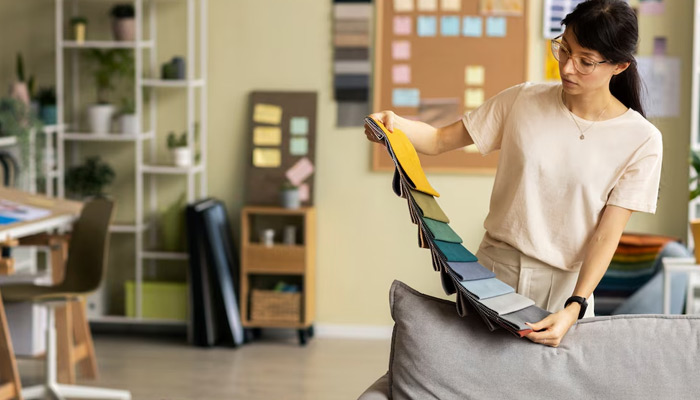
54. Use an event to motivate your decluttering efforts
Entertain: Throwing a party, from an intimate dinner to a large BBQ, can motivate us to declutter as we prepare for company. Use social, happiness-producing events for clutter maintenance.
Move: Moving motivates us to evaluate our stuff and release the extraneous. The more you edit and declutter before a move, the faster your home will sell, and the easier it’ll be to organize your new space.
Sell: Having a yard sale gives you a specific deadline to work towards, increases your letting-go motivation, is an enjoyable social activity, and lets you make a few bucks in the process. It’s also fun to meet the buyers of your stuff.
Learn more: Move-Out Move-In Cleaning Checklists You Can Actually Use
55. Get your kids on board
Set times each day for restoring order. Avoid using the words “clean up,” which children interpret as “make look pretty.” This leads to items being tossed into the nearest container.
Teach children that a space needs to be reset, with items going back into their homes. Do this at least once a day, and maybe more if children are in the space all day. For example, consider a cleanup before lunch and before dinner.
56. Keep these three things in your bag to stay organized on-the-go
- Cord Tacos for wrangling cords and earbuds (lifesavers, since wires can become a tangled mess).
- Scannable app for taking photos of receipts and recycling paper.
- A portable iPhone charger.
57. Use these four apps to digitally organize and save time
Snooze: Allows the user to snooze an email until they are ready to deal with it.
Snippets: We often type the same text over and over; emails, phrases, introductions – the list goes on and on. Snippets save time by allowing you to create templates of saved text that you can insert within any email just by typing a short command.
Todoist: A task management app that coordinates effortlessly with Gmail. There are so many great features but my favorite is the ability to create to-dos from actual emails, therefore getting rid of the email. Emails can’t be prioritized, but in Todoist, they are.
FileThis: An online tool that helps me stay paperless. FileThis logs into each of my accounts and files my statements in Dropbox. It also alerts me when things are coming due so that nothing falls through the cracks.
58. Seek functionality over visual appeal
This is the best way to ensure you can stay organized. Organizing is about creating systems that cater to your needs, not just tidying up or putting things in piles. If you’re a visual person, label everything!
59. Take baby steps for your organizing goals
If it gets overwhelming, you will lose interest and momentum. A little bit every day, but continuity is key.
Organizing is not an end destination, it’s a process of acquiring skills, applying them, and being committed to being organized every day.
60. Set aside time and energy
Before one can start a decluttering strategy, one needs to make sure to:
- Schedule blocks of time for every single project.
- Plan in advance by putting every single project on a calendar.
- Have someone to help on the projects that are too heavy, too emotional, too time-consuming.
61. How to begin decluttering if you’re overwhelmed by all your stuff
Once you start purging items (donate, trash, or consign) you’ll likely feel relieved, and even motivated to move on to another area.
Enlisting the help of a friend or family member to help you get through the task will give you the support needed to finish the (sometimes daunting) task at hand.
Tip: Start in the kitchen and pantry to weed out any expired food. I’m sure you’ll be surprised at what you’ve been holding onto, and will be inspired to tackle the next spot!
62. Be strategic when packing for a trip
Create a list of items that you need to bring to ensure that you never leave without the essentials. Tip: Make a digital version on your computer so you can reference it for each trip.
Plan full outfits in advance (rather than bringing seven tops and four bottoms for a weekend trip), so that you know exactly what pieces work together and what you are comfortable wearing. That’s preferable to lugging around extras, “just in case” the outfit didn’t work out like you envisioned in your head. Similarly, ignore the “what if” scenarios!
Be realistic with the amount of options that you bring and stick with that number when choosing your clothing.
Tip: Stick with a color scheme and choose options based off of the scheme to ensure that all clothing, shoes, and jewelry can be mixed and matched!
63. Keep your suitcase organized when traveling
Store smaller items and accessories in mesh bags. Keep your undergarments in a bag, wires and electronics in a bag. This will keep things in your suitcase tidy.
Refrain from leaving trash in your bag. It’s a suitcase, not a trashcan!
Store toiletries in a clear plastic bag. This will keep them safe from spills and easy to see.
Learn more: 7 Super Creative And Cheap Ways To Store Your Luggage
64. Create an itinerary to organize your travels
An itinerary is a useful reference when it comes to your personal or professional travels. What’s more, the physical act of preparing your itinerary helps you to organize, process, and digest information related to your trip.
To create your own itinerary, gather necessary travel documents and related information. Then, open a word processor or text editor, and create sections for general information, dates/times, and notes.
Next, write down all the dates of your trip. Using your travel documents and related info, fill in the details for each day, working your way from morning until night.
Lastly, don’t forget to proofread and double-check your work.
65. Rotate Your Closet Seasonally
As the seasons change, so do your clothing needs. To keep your closet organized and efficient, rotate seasonal items to the front while storing out-of-season clothes in bins or on higher shelves. This not only frees up space but also ensures that what you need is easily accessible. For example, as winter approaches, bring sweaters, coats, and scarves to the forefront, while tucking away summer attire. This rotation keeps your wardrobe neat, prevents overcrowding, and makes getting dressed a breeze, all while preserving your garments for their specific season.
5 Dos and Don’ts of Home Organization
Dos:
- Do Prioritize Functionality: Organize in a way that fits your daily needs. Make sure the items you use most frequently are easily accessible.
- Do Label Containers: Labels make it easier to find and return items to their proper places, keeping your system intact.
- Do Declutter Regularly: Regularly go through your belongings and declutter. This prevents buildup and keeps your home in a constant state of organization.
- Do Use Storage Solutions: Invest in baskets, bins, and drawer dividers to keep everything in its designated spot and reduce visual clutter.
- Do Involve the Family: Make organization a family affair. Teach kids and other household members to follow the system so everyone contributes to maintaining an organized home.
Don’ts:
- Don’t Hold on to Unnecessary Items: If you haven’t used something in a year, it’s time to let it go. Avoid keeping items “just in case.”
- Don’t Overcomplicate the System: Simplicity is key. Avoid overly complex systems that are hard to maintain or that others in the household won’t follow.
- Don’t Neglect Hidden Areas: Closets, drawers, and cabinets deserve as much attention as visible spaces. Keeping these organized prevents clutter from creeping back.
- Don’t Expect Perfection: Home organization is about practicality, not perfection. Aim for a functional system that works for your lifestyle rather than stressing over every tiny detail.
- Don’t Procrastinate: The longer you wait to organize, the more overwhelming it becomes. Start small and keep up the momentum to make a significant impact.
Conclusion
It’s no secret that getting organized is hard work. But sometime between restructuring your fridge and taming that paper dragon, take a step back. Breathe. Appreciate the extra space you’ve created.
And when you’re ready to make even more space?
Store with Peace of Mind—Secure Your Space Today!
We’ll pick up any bulky winter coats standing between you and your soon-to-be she-shed. Then, we’ll transport your items to our secure temperature-controlled storage facility. We’ll even create an online photo catalog of your stuff so you always remember what you have in storage.
And when you want something back, simply log into your Clutter account, select the item’s photo, and we’ll deliver it to you.
Now that’s an organizing hack.
FAQs for Best Organizing Tips and Ideas From Professional Organizers:
Q: How frequently should I refresh my organizational efforts?
It’s a good idea to reassess your space every few months. As your needs and lifestyle change, so should your organization. Regularly decluttering and reorganizing prevent things from piling up and keep your home functional and tidy.
Q: How can I organize my home on a budget?
You don’t need expensive tools to organize effectively. Repurpose items like shoe boxes, jars, or baskets you already own. Focus on decluttering first—having fewer items to manage makes organization easier. Additionally, DIY solutions like wall hooks or creative storage methods can be both affordable and functional.
Q: What’s the best approach for managing sentimental items?
When handling sentimental items, start by asking yourself if the item truly adds value to your life. Consider keeping only a few key pieces that evoke meaningful memories. You can also take photos of sentimental items as a way to preserve the memory without holding onto the physical object.
Q: How can I organize a small entryway efficiently?
Use vertical space by installing hooks or shelves to keep items off the floor. A small bench with hidden storage or baskets can help store shoes, bags, and other essentials. Keep the area simple—less clutter means a more functional and welcoming entryway.
Q: What’s the best way to organize shared spaces when living with roommates?
For shared spaces, communication is key. Discuss expectations and set clear guidelines for shared areas. Create designated spaces for everyone’s belongings using labeled baskets or shelves. A shared cleaning schedule can help maintain organization and prevent clutter from building up.


